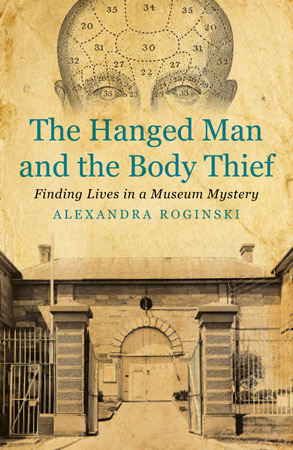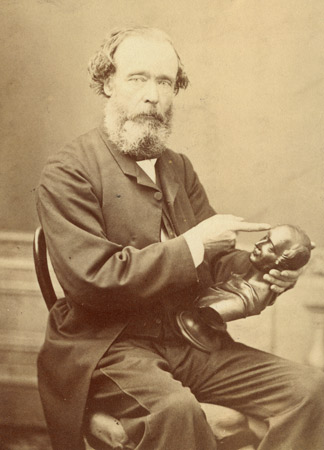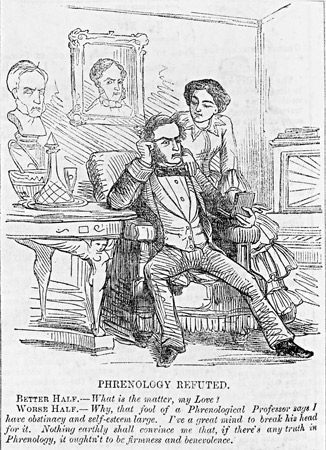by Tom Griffiths
The quest that is the origin of this book began in a museum cabinet. That is where much important research starts – for museums are dynamic, they are sites of renewal and discovery, they are not just an end-point, not just a final repository. Museum collections are full of lives and stories – and they can surprise us. That is one of the messages of this wonderful book. Alex Roginski begins this story sitting in the research room of the Humanities Department of Museum Victoria with a manila folder in her hands. It is a file with some scraps of information about a human skull in the museum’s collection, a skull with a barely legible label that appeared to read: ‘Jim Crow, Aboriginal … executed … land … capital offences’. Roginski has respectfully held that skull in her hands too, searching for signs of identity. It was her responsibility, her appointed task, to read the skull – and her assignment led her to people in earlier times who also read skulls, but for different purposes. It was her burden to share that peculiar role with them. For the skull in the museum could only be repatriated if the origins and cultural affiliation of the remains could be discovered.

Monash University Publishing
A skull is an object that is so intensely and intimately personal that it is not an object. Yet a skull is also bare bone, a material relic so stripped of individuality that it represents our physical humanity at its most basic and universal. The skull seems to be the repository of who we are; it is the site of our being and personality: the head, the face, the brain. Yet bone is ultimately just bone. How do we read a skull for its cultural history, and how do we find the people and country it came from? What life had lived within the skull? Who was Jim Crow? How do you, as Roginski puts it, ‘breathe life into the skull to try to make him into a human being again’?
Searching for Jim Crow is what this book is about, and along the way we are introduced to three compelling people. The first, of course, is Jim Crow himself. His death and protracted earthly afterlife were more public than his brief existence. Like many Aboriginal people on the pastoral frontier, he inhabited the margins of documented life and perhaps he intended it that way. He is caught in the settler record only by the institutions of prosecution and punishment. He was a slight Aboriginal man of about 25 years who came from the district of Maitland, north of Newcastle, New South Wales. We don’t know his real Aboriginal name, and only a few of his utterances were recorded, all under the stress of prosecution. On 24 January 1860 at about 11 am, Jim Crow visited a farmhouse in a township near Dungog and asked for water. Jane Delanthy was at home, and she did not have water, but offered him coffee instead. She was pregnant and at home alone with a young child while her husband was away working at the threshing machine for the day. While Jim Crow sat on a stool and drank coffee, she made conversation. What then happened was contested at trial and ended with them both running away in different directions. Jane Delanthy accused Jim Crow of rape; Crow pleaded not guilty. The jury found Jim Crow guilty but recommended him for mercy. Justice John Dickinson, however, sentenced him to death. In the book, Roginski sifts the evidence and asks the fundamental question: Would Jim Crow have been convicted and executed were he not Aboriginal? She finds that he would not have been.
The second compelling person to whom we are introduced in the book is a man named Archibald Hamilton, a morally ambiguous character. We meet him in his early 40s, six years after his arrival in the Australian colonies from Scotland, making a living as a phrenologist. Phrenology was a popular 19th-century science that consisted of reading the shape of people’s heads to discern their moral and intellectual character. Phrenologists were obsessed by race and criminality. Archibald Hamilton was in the Maitland area giving public lectures that featured real human skulls, and he had been among the onlookers at Jim Crow’s execution within the sandstone walls of the Maitland Gaol. Four months later, on a moonlit night, Hamilton attempted to have Crow’s head exhumed from its grave in St Peter’s Church of England Cemetery in East Maitland. This immediately led to the prosecution of Hamilton for inciting grave-robbing, and thus the book’s second courtroom trial begins …

Hobart Archives and Heritage Office SC89/1/2 1871 48
Alex Roginski, our author, issues a warning to her readers: ‘The challenge of dealing with loud historical figures such as Hamilton is that, no matter how gruesome their behavior, we start to warm to the very humanity of their voice.’ So we are introduced to a man who was bombastic, self-important, melodramatic, probably violent, sometimes charming, a showman. Hamilton, as well as being a body thief, was an ardent campaigner for the abolition of capital punishment, and in 1880 pleaded for a reprieve for Ned Kelly. In his 1860 trial for inciting grave-robbing, Hamilton, probably relishing the opportunity for performance, chose to defend himself in the court, and the jury took just 15 minutes to acquit him. At some time in the next two years he returned to St Peter’s Church of England Cemetery, dug up Jim Crow’s body and removed the skull. It then joined his collection of more than 50 skulls of known people and became a prop in his popular phrenological lectures.
The third enigmatic person to whom Roginski introduces us in this book is Agnes Hamilton, Archibald’s third wife and, from 1884, his widow. She was 34 years younger than him, a ‘soft beauty’ who was his amanuensis and secretary and who, after Archibald’s death, possibly had a relationship and a child with the future Australian prime minister, George Reid. In her final years Agnes also wrote biographies of the poet Henry Kendall. In 1889, five years after Archibald’s death, she gave his collection of skulls and yellowed labels, together with some papers, to the National Museum of Victoria. The donation, which Agnes hoped would memorialise the work of her late husband, was accepted by the museum and travelled by steamship from Sydney to Melbourne. When the collection entered the museum, it continued to have a history, as Roginski carefully explains – a contested history of custody, neglect, research and rediscovery that led to the writing of this book.
I said that the book introduces us to three compelling people. But there is a fourth. There is a fourth figure whom we encounter in these pages and who becomes our guide. It is Alex Roginski herself. Her presence is quiet, subtle and respectful, but it is compelling too. The extent to which an author declares herself in a work of history is always a delicate matter, and here it is beautifully done. We meet her in the museum at the beginning of her research, she is our questing companion, thinking aloud, asking questions, inviting us to look over her shoulder as she reverently handles crania, examines labels, sifts data, walks in a cemetery, sits at her desk, and even as she googles. Trove comes out of this book very well! For the uninitiated, Trove is the digital marvel that, in response to a few key words, can dredge a century of newspaper reports and retrieve a forgotten fragment just for you – it replaces the days and weeks we historians used to spend spooling through newspaper microfilm. It delivers power and responsibility into our hands with bewildering speed. But the intellectual hard work remains to be done and still takes the same painstaking time. Nothing can short-cut deep thinking; nothing can replace careful contextual analysis; nothing can supplant detailed cross-examination of evidence. All of this is on show here too. Roginski is a master at extracting meaning from the tiniest detail and she writes with mischievous wit and literary flair. We see Roginski’s legal training employed in her sharp focus on the two trials at the heart of the book; we see her forensic eye scrutinising evidence, written and material; we come to share her heartfelt engagement with the moral challenges this research raises. This is one of the benefits of readers meeting this fourth person. Through her delicate presence in the book and her dialogue with the reader, Roginski is able to negotiate the cultural sensitivities openly. It is a way of dealing with the grisly and the macabre without sensationalising them. She writes that ‘The cumulative impact of the Hamilton remains is sometimes heartbreaking, sometimes chilling’. We are enabled to feel that impact too, and thus to share in the responsibility for what happens next.

Rare Books Collection, State Library of Victoria
What happens next is ultimately what this book is about. Roginski finishes the book with the words: ‘I hope it will allow Jim Crow to return home’. On 30 June 2015, the day following the launch of the book, that journey began. A solemn handover ceremony took place at Melbourne Museum, and Jim Crow travelled again, this time with friends, back to country. There was justice to be done and reconnections to be made: of skull to person, of bone to life, of man to country.
Jim Crow’s story enables us to step back and consider how museums have been dealing with their colonial legacy and to reflect upon the vital, creative role of museums in our culture. Over the last thirty years we have lived through a challenging and significant change in the relationship between museums and Indigenous peoples. From the 1980s museums increasingly turned their attentions from past objects to present peoples, and Aboriginal studies resolutely crossed the great divide from science into the humanities. Lindy Allen, a distinguished scholar from Museum Victoria, has observed that returning materials can sometimes be one of the most important things a museum does. It’s true. Our large museums now devote care and attention to the serious process of repatriation. In her book, Roginski acknowledges the inspiration of an essay called ‘Where are the stories?’, written by National Museum of Australia curator and repatriation expert, Mike Pickering (The Public Historian, vol. 32, no. 1, 2010). In that essay, Pickering urges us to document and tell the stories of these grim museum collections, for it is the stories that ‘compel us to look at, and respect, the object on the table, the remains, as an individual’. This is the large task to which Roginski’s book contributes so thoughtfully: a revolution we are living through in our understanding of the Indigenous peoples of this country and their rights to history, heritage and land, a revolution in which historical research and museum collections are playing a vital role.
Over 20 years ago, when I was writing my book Hunters and Collectors (1996), I was lucky enough to work for a while, as a guest researcher, in the same department of Museum Victoria where Roginski began work on her book, and some of the same wonderful scholars and curators who helped me then have helped Roginski now. How lucky we all are that they are there still, such is their dedication to their museum and its collections. They bring an immensely valuable continuity to this important work at a time of rapid change; they curate not only collections but also crucial institutional memory. We all owe them a great debt for their sustained, sensitive work – as we do many other curators in museums across Australia.
This is a powerful and important book, beautifully written, and sparkling with intelligence and flair. It is truly a gripping read, suffused with hauntings but also with hope, and one feels the power of the past in the present on every page.
These comments are adapted from a speech given by Tom Griffiths on 29 June 2015 launching Alexandra Roginski’s book, The Hanged Man and the Body Thief, Monash University Publishing, Melbourne, 2015.
